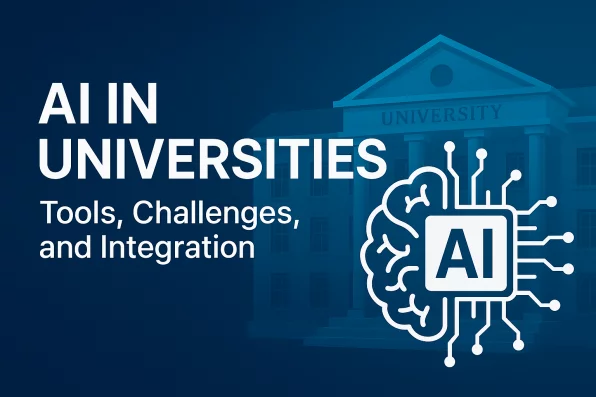Summary: Artificial intelligence (AI) has rapidly become a fixture in universities across the world. This article examines the dual nature of AI—as an educational tool and as a potential threat—by drawing on recent research, expert insights, and real-world examples. Learn how universities can integrate AI ethically, improve learning outcomes, and ensure equity across diverse educational landscapes.
The AI Revolution on Campus: Adoption and Impact
Artificial intelligence in higher education is no longer a theoretical concept—it's a reality shaping daily academic life. As of 2025, more than 92% of students report using AI tools regularly, and 88% rely on generative AI for assignments and exam preparation. This marks a staggering increase from just a year prior. AI is now present in every facet of academic operations, from smart tutoring to automated grading.
Institutions across the globe are actively adapting to this surge. For example, adaptive learning platforms that customize lessons and real-time tutoring delivered via chatbots are increasingly common. Learn more about how innovative universities are leading the way in AI integration and student support.
Yet policy has not kept pace. While the majority of students use AI freely, only 29% say their universities support this use, and 40% say their institutions actively discourage it. This wide adoption without clear direction has prompted calls for updated governance and institutional alignment.
AI as a Powerful Academic Tool
From lesson delivery to administrative operations, AI is proving itself as a formidable educational advantage. Among its most prevalent uses:
- Personalized Learning: Tools that adjust content delivery to individual learning speeds and styles boost engagement and comprehension.
- Instructor Efficiency: Automated grading, scheduling, and content suggestions reduce administrative burdens, freeing up to 44% more time for educators to focus on student outcomes.
- Accessibility: Speech-to-text technology, translation software, and AI-generated summaries help bridge language and ability barriers in diverse classrooms.
- Accelerated Research: AI aids academics by automating literature reviews, data organization, and even drafting proposals—enhancing efficiency across disciplines.
This practical adoption matches the expectations set for leading academic institutions. For a deeper example of emerging strategies, explore how Africa’s top-ranked universities leverage tech for innovation and accessibility.
The Risks of AI in the Academic Sphere
Despite its promise, AI poses serious challenges in higher education. Chief among these concerns is the erosion of assessment integrity. With automated tools capable of composing essays and solving problems, the line between learning support and academic dishonesty is fading fast. Institutions must reassess how they evaluate student understanding—shifting toward more authentic, AI-resilient assessments.
Additional risks include:
- Bias and Injustice: AI systems can reinforce existing stereotypes or exclude minorities if datasets are skewed or not properly audited.
- Skill Atrophy: Overreliance on automation may reduce students' development of independent critical thinking and communication skills.
- Privacy Concerns: As AI collects increasing amounts of student data, ethical use and protection become a regulatory imperative.
Ethical Frameworks and Institutional Best Practices
To confront these challenges head-on, leaders in higher education are advancing balanced strategies that encompass both innovation and caution:
- Ethical AI Policy: Universities are forming cross-disciplinary committees to shape flexible guidelines, balancing student freedom with academic integrity.
- Responsible AI Literacy: Leading institutions are launching training programs that emphasize ethical use, critical evaluation, and fundamental AI capabilities.
- Equity and Access: Programs aimed at closing the digital divide ensure equal access to AI tools and foster technological fluency across all demographics.
- Assessment Overhaul: Reflective assignments, collaborative projects, and performance-based testing are replacing traditional multiple-choice exams.
- Community Dialogue: Ongoing feedback loops involving students, faculty, and technologists help refine policy and practice in real-time.
Key Data and Market Trends
The numbers behind AI integration in education are striking:
- 92% of higher education students use AI regularly; 88% refer to generative AI for academic work.
- By Q4 2025, AI will automate nearly 100% of multiple-choice grading and 50% of essay evaluations.
- Faculty uptake is rising, with 60% using AI tools for planning, content creation, and administrative tasks.
- AI adoption saves 44% of educators’ time on non-teaching duties.
- The global AI in education market is set to surge from $3.6 billion in 2023 to over $73 billion by 2033.
Despite rapid adoption, a major gap persists: few universities currently offer structured programs on AI bias, ethical design, or responsible data use. Addressing this training gap is paramount if institutions are to maximize AI’s potential without compromising values or equity.
Expert Commentary: What Education Leaders Are Saying
“It is almost unheard of to see changes in behaviour as large as this in just 12 months... Generative AI is here to stay.” — Josh Freeman, Higher Education Policy Institute
“There is an opportunity to support students in developing the skills to use these technologies effectively and ethically.” — Robin Gibson, Kortext
“AI is transforming higher education by making it more efficient, personalized and data-driven, but not without risk.” — Market.US, via Rockhurst University
The Strategic Path Forward for Institutions
The most effective higher education institutions are moving from reactive decisions to proactive AI strategies. Key steps for safeguarding academic value while leveraging innovation include:
- Creating Future-Proof Policies: Build living frameworks adaptable to AI’s rapid evolution.
- Investing in Digital Infrastructure: Ensure all communities have access to AI tools and internet connectivity.
- Promoting Interdisciplinary Education: Combine ethical reasoning, data science, and humanities within AI literacy programs.
- Building Innovation Labs: Test, evaluate, and refine AI tools through campus-based experiments.
Universities that fail to take action risk widening the educational divide and diminishing trust in learning systems. Proactive inclusion and thoughtful governance must lead the way.
Final Thoughts: AI’s Dual Role in Higher Education
Artificial intelligence is rewriting the educational script. For students, it’s both a study partner and a potential crutch. For teachers, it’s a means to enhance impact—and a challenge to pedagogical traditions. For institutions, it’s an opportunity not just to react, but to lead.
Educational leaders must acknowledge a new reality: AI is already influencing how the next generation learns, thinks, and creates. Strategic investment in resources, policies, and people is no longer a choice—it is imperative.
The question is not whether AI is a tool or a threat, but how we choose to wield it. Now is the time for bold, collaborative action to ensure AI serves learning, equity, and innovation—not at their expense, but in concert.
Action Steps for Stakeholders
- Students: Use AI to deepen understanding. Push for AI literacy programs at your institution.
- Faculty: Shift toward mentorship-focused teaching. Stay informed about emerging AI tools and risks.
- Administrators: Lead with clear vision. Champion investment in training and accessibility.
- Policy Makers: Support research, fund innovation, and ensure AI promotes public good in education.
In the age of artificial intelligence, higher education’s future is being shaped not only by algorithms—but by the people who choose how to apply them.



